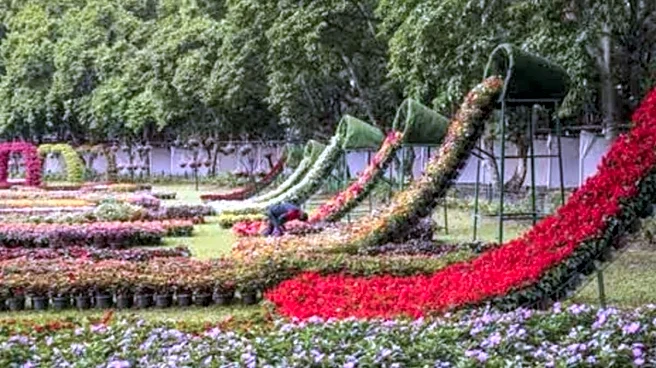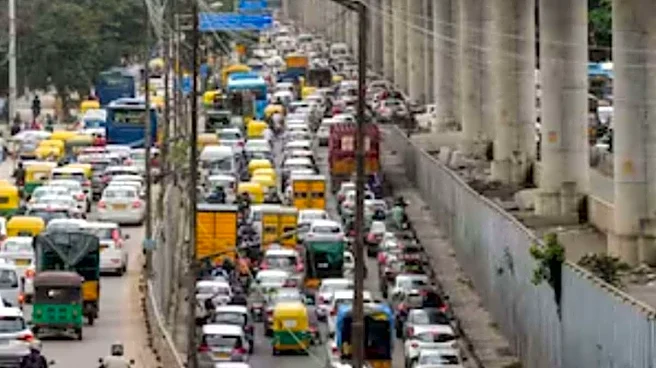Despite growing criticism over the 16.7-km tunnel road between Hebbal and Silk Board, Bengaluru’s municipal body seems undeterred. The Bruhat Bengaluru Mahanagara Palike (BBMP) has floated bids for a detailed project report (DPR) for another tunnel—a 28-km stretch linking KR Puram to Nayandahalli.
For now, the BBMP has only invited bids to prepare detailed reports, but the public backlash suggests the project won’t move forward quietly. Between technical contradictions, environmental warnings, and political mudslinging, the Lalbagh tunnel could become yet another symbol of Bengaluru’s struggle between development and preservation.
At the heart of this controversy lies one of Bengaluru’s most cherished landmarks—the Lalbagh Botanical Garden. Once
celebrated as the city’s green lung, it now faces the prospect of becoming collateral damage in the government’s rush to build what it calls “future-ready infrastructure”.
The tunnel, if built as proposed, will pass directly under Lalbagh, running perilously close to its lake and ancient rock formations. The DPR itself shows that the project will cut through a 700-metre section beneath the garden, with two 50-foot-wide tunnels and a massive ventilation shaft piercing the subsoil that sustains Bengaluru’s most precious ecological site.
As the debate continues, one question hangs heavy over the city’s oldest garden: will Lalbagh survive this latest urban experiment—or become its biggest casualty?
An Engineering Feat or Ecological Disaster?
On paper, the project sounds like a marvel of modern engineering—twin tunnels, deep ramps, and a complex underground network designed to ease traffic. But for environmentalists, it’s a nightmare waiting to happen.
The DPR estimates that nearly six acres of Lalbagh land could be acquired to make way for access ramps and ventilation systems. The entry ramp will start just 50 metres from the Ashoka Pillar, and the exit will surface near Marigowda Junction.
Perhaps the most visible impact, however, would be on the trees. Lalbagh is home to an estimated 3,000 species of plants, including rare and heritage trees—some more than a century old. The DPR is silent on how many trees will be cut or relocated.
According to the BBMP’s design, this road will channel vehicles from Shantinagar, Wilson Garden, Dairy Circle, and Jayanagar towards Hebbal—but not in the reverse direction.
Activists argue that this will only worsen congestion around Lalbagh and choke nearby neighbourhoods with traffic, noise, and dust.
One of the biggest fears among experts is the future of the 3-billion-year-old Lalbagh Rock—one of the oldest rock formations on Earth, recognised as a National Geological Monument by the Geological Survey of India in 1975.
The project plans to bore tunnels using heavy machines right through this formation. Experts warn that this could crack the rock and make the ground unstable. If that happens, this ancient geological treasure will be lost forever.
They also warn that tunnelling under Lalbagh’s 40-acre lake could disturb the underground water channels that feed it. This could lead to flooding, drying up of the lake, or even contamination of the water. The lake, which collects rainwater and supports fish, reptiles, amphibians, and migratory birds, plays a key role in maintaining the cool microclimate of the garden. Any disturbance below the surface could destroy that balance.
Environmentalists also point out that constant drilling and excavation will harm the roots of hundreds of trees. Those within the affected area will die, and others nearby could weaken over time. For many, the idea of destroying greenery inside a botanical garden in the name of development is unexplainable—and plain murder in broad daylight, say activists.
Shivakumar’s Assurance: ‘Lalbagh Will Not Be Touched’
Facing the mounting backlash, Karnataka deputy chief minister DK Shivakumar stepped in to calm tempers. Over the weekend, during his “Bengaluru Walk” event at Lalbagh, he listened to citizens’ concerns and promised that the botanical garden would remain untouched.
Explaining the decision, he said that Lalbagh is public property and that every measure will be taken to preserve it.
“There is no need to acquire six acres for the tunnel project. Only half an acre near the Ashoka Pillar will be used for access and exit. Another one acre of the parking area may be temporarily used for storage and later restored,” he told the people who raised concerns.
Shivakumar insisted that the tunnel will not disrupt Lalbagh’s greenery or biodiversity. “Small trees will be removed and replanted. Lalbagh Garden will not face any disruption,” he said, while adding that the tender process had already been initiated and bids were being evaluated.
But the deputy chief minister’s assurances have done little to allay fears. Environmentalists and citizens remain unconvinced, pointing out that the DPR’s technical details contradict his statements.
As a goodwill gesture, Shivakumar also announced that the civic agency will allocate Rs 10 crore for Lalbagh’s development. “We will provide funds to improve facilities, create a gym for senior citizens and women, and ensure better maintenance,” he said during an inspection of the proposed tunnel access points.
What Does the Project Really Aim to Achieve?
The tunnel road project is part of the government’s larger vision to decongest Bengaluru’s traffic—an ambitious plan to link the city’s major corridors through underground roads. For Shivakumar, it represents both a test of leadership and an opportunity to showcase visible urban development.
By pushing the tunnel plan, he hopes to project the Congress government as one delivering modern solutions to Bengaluru’s civic woes—in contrast to the BJP’s years of stalled projects. His announcement of Rs 10 crore for Lalbagh’s development and promises of new tree parks appear aimed at balancing the narrative between growth and green preservation
The DPR and the Disconnect
While Shivakumar insists that only minimal land will be used, the DPR reviewed by civic forums paints a different picture. It details large-scale excavation beneath the garden and extensive construction activity along its boundary.
Two tunnels, each 15 metres in diameter, will be built with major entry ramps from Ashoka Pillar and Wilson Garden, both within proximity to Lalbagh. A 1.4 km entry ramp and a 1.1 km exit ramp will require space for heavy machinery, ventilation shafts, and service lanes.
Activists say such massive construction cannot possibly happen without disturbing the garden’s ecosystem. The matter is simple—even if tunnelling happens underground, vibrations from boring and excavation can harm roots and soil structure. The DPR doesn’t address how these impacts will be mitigated.
Adding to the confusion, Shivakumar’s public statements about land usage and the DPR’s technical layout appear to be at odds. While the government claims no acquisition inside Lalbagh, the DPR clearly outlines land demarcations within its boundary for tunnel infrastructure. These demarcations were visible just before the DCM’s visit to Lalbagh.
Civic Forums Take the Lead
In July this year, Citizens for Citizens (C4C), one of Bengaluru’s civic groups, formally wrote to the horticulture department opposing the project. The letter, addressed to department secretary Shamla Iqbal, urged that the proposal be scrapped to safeguard the ecological and geological sanctity of Lalbagh.
“The massive excavation work will disrupt water tables, aquifers, and the delicate ecology of Lalbagh Lake,” the letter stated. “The project threatens heritage trees and aquatic life due to vibrations and soil shifts during tunnelling.”
C4C’s founder, Rajkumar Dugar, explained that the ramps alone—stretching over a kilometre on either side—would lead to large-scale tree cutting, root damage, and hydrological disturbance. “The project, in its current form, poses geological, hydrological, ecological, and civic risks, not just for Lalbagh but for Bengaluru as a whole,” he said in the letter.
Lalbagh Botanical Garden was started by Hyder Ali in 1760 and later expanded by his son Tipu Sultan, who introduced several exotic plant species from Persia, Afghanistan, and France. In 1856, the British took over its management, transforming it into a botanical garden for scientific study and conservation. Over time, Lalbagh became one of Bengaluru’s most treasured landmarks—a 240-acre green oasis that helps regulate the city’s temperature, improve air quality, and preserve biodiversity. But today, activists say, this historic garden is under threat, with multiple infrastructure projects, including the proposed underground tunnel roads project, set to cut through its delicate ecosystem—putting at risk the very space that helped Bengaluru earn its title of “The Garden City”.
Political Firestorm
As environmentalists raise the alarm, the controversy has quickly turned political, with the BJP attacking Shivakumar for what it calls his “vanity project” that endangers Lalbagh and the city’s environment.
Leader of the opposition R Ashoka said, “Lalbagh is Bengaluru’s pride—a living heritage. It is now under grave threat from the reckless Rs 26,000 crore tunnel project being pushed by DK Shivakumar,” Ashoka posted on social media, tagging his campaign #SaveLalbagh and #CongressFailsBengaluru.
He alleged that the project would destroy six acres of green space and result in the loss of thousands of trees—“all for one man’s publicity stunt.”


/images/ppid_59c68470-image-176002764746714698.webp)


/images/ppid_a911dc6a-image-176017409857877919.webp)





/images/ppid_a911dc6a-image-175997864610344658.webp)




